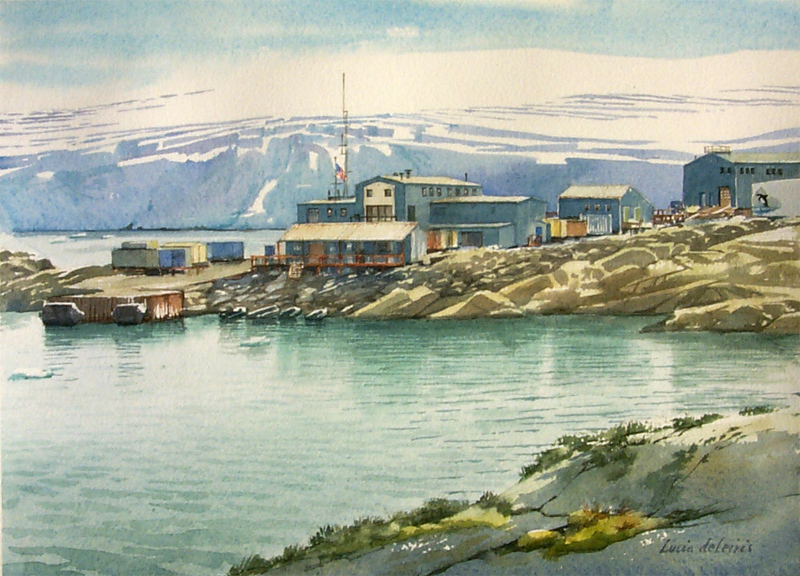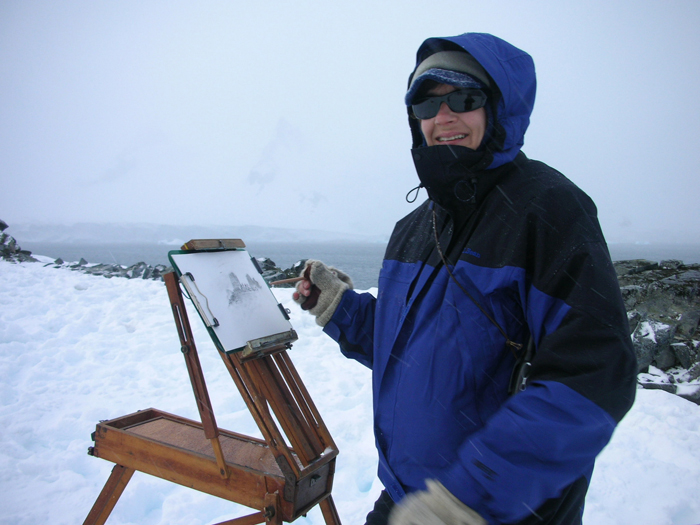 Painting in Antarctica
Painting in Antarctica
by Lucia deLeiris
On three trips I spent a total of ten months painting and illustrating in Antarctica as part of the National 
During the Antarctic summer of November 1985 to March of 1986, after a four day trip across the Southern Ocean, I lived four months at Palmer Station on the Antarctic Peninsula. There I illustrated the book Natural History of the Antarctic Peninsula (Moss, Columbia University Press, '88) and painted for exhibitions. Two solo exhibitions followed, one at the Newport Art Museum, the other at the Smithsonian Museum of Natural History in Washington, DC.
1985 to March of 1986, after a four day trip across the Southern Ocean, I lived four months at Palmer Station on the Antarctic Peninsula. There I illustrated the book Natural History of the Antarctic Peninsula (Moss, Columbia University Press, '88) and painted for exhibitions. Two solo exhibitions followed, one at the Newport Art Museum, the other at the Smithsonian Museum of Natural History in Washington, DC.
With temperatures in the 30°s and 40°s Fahrenheit, I was dropped off by rubber Zodiac on nearby islands each day. I brought a radio and sometimes my tent. There I spent whole days sketching, painting small watercolor studies, and taking notes and photographs.
Sitting near the Adelie penguin nests, observing the progression of the breeding cycle over the summer season, I watched as they squabbled, stole stones from each other's nests, courted, and fended off the predatory skuas flying overhead. On other islands, I saw Antarctic terns and watched the tiny balls of gray down emerge from their spotted eggs. I sat near two ton elephant seals, sketching their massive forms from all angles. I was never more content. Those days on the islands were the realization of a dream.
On a nine day cruise south into the pack ice of Marguerite Bay, where the conditions were colder and more extreme, I sketched from the deck of the ship and from the crow's nest when the rolling of the ship was stilled by the thick sea ice. I painted the deep cerulean icebergs and the pastel pinks of the pack illuminated as the low sun circled the sky.
That short glimpse of the pack ice, gave me a sense of another planet--of something out of the realm of my experience. It led to my desire to return to Antarctica to an area further south, more extreme -- and to go there during the spring, when the sun creeps low over the horizon, bathing the landscape with pink, violet, and golden hues.
In the southern spring of 1995 I returned to do landscape painting, this time to McMurdo Station, south of New Zealand. There I set up a field camp with a writer, whom I met there. She and I worked for several weeks in two wooden fish huts on the sea ice 15 miles from the station or two hours by Spryte, our tracked vehicle.
In August when I arrived, the sun was up just three hours a day, but the long twilight provided hours of inspiring sights. The daylight lengthened rapidly. By the time I left two and a half months later the sun never set, but instead circled the sky, barely touching the violet tips of the distant Transantarctic Mountains at midnight. The changing blues, magentas, violets and amber tones, the long traveling shadows, and the luminous effects of the low sun rays on the varied ice forms were a source of constant inspiration for painting.
At first, temperatures in the minus 30°s, 40°s, and 50°s (Farenheit), and wind chills of minus 115° made painting difficult. I painted from every heated window I could find in science field camps. I often painted the same subject in different lights as it changed moods at different times of day, in varying weather conditions, and as the season progressed. As the coming of late spring warmed the air to the minus 10°s and 20°s, I was able to paint from heated vehicles and do pencil sketches outside with thick gloves on.
The warming trend brought wildlife to our sterile environment. One evening, after spending two weeks in our camp painting the lifeless landscape, I stood outside peering into the pink light of dusk. Squinting into the distance, I made out 5 dark shapes on the ice. I pulled out the binoculars and could see in each sleek form the distinctive Weddell seal silhouette, an occasional flipper rising up against the soft pink sky as it rolled over.
The next day I hiked over to the group of seals and sat near a pregnant female. I sketched her, hoping to capture that serene expression in her eyes, the sleek fur texture and the round forms of thick fat layers that kept her from the biting cold. I sketched until the cold seeped through my clumsy gloves and stiffened my fingers.
In 1998-1999, I returned to the Antarctic Peninsula, to illustrate a forthcoming natural history book for young people, to paint, and to do field drawings for future reference. After my experience at McMurdo, the 28°- 38° weather seemed quite balmy as I headed out once again in a zodiac plowing through chunks of ice, to sketch the Adelie penguins, elephant seals, and cormorants on the many islands.
The animals of Antarctica seemed undaunted by my presence, accepting of a foreign creature in their land. I recall how the Weddell seals lay ignoring my presence as I sketched the peaceful expression in their eyes. I recall sitting near an Adelie penguin colony, when one juvenile scurried up and tugged at my mitten as I sketched. There was an unusual harmony in this paradise-like land. To this day, the frozen continent warms my spirit in memories and images.

